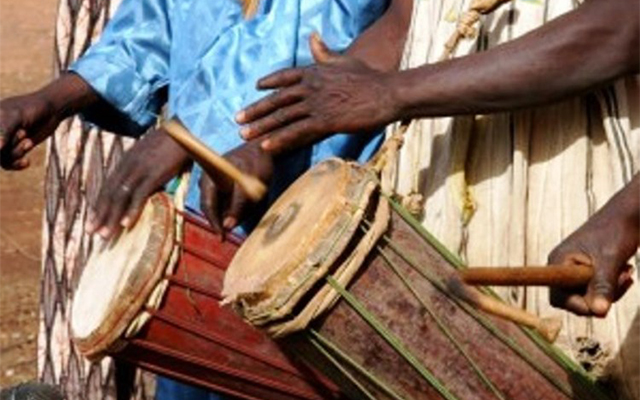Zino Irema: The missing village drum

Sekai Nzenza On Wednesday
My mother’s drum called Zino Irema has disappeared. Zino Irema is loosely translated to say the tooth is a fool because it presents itself to people and is used for smiles, even when the smile is not real or genuine. Zino Irema is the drum of my childhood. There was not just one Zino Irema. No. There were generations of them. When we were growing up here, there were drums in Mbuya VaMandirowesa’s granary. Among them was the big one called Zino Irema. During ceremonies, it was played all night. In those days, the elders sang ancient songs like mbavarira woye woye, imbwa yangu machena, mhondoro dzinonwa muna Save. We felt that Zino the drum was communicating with us, joining in our celebrations and in our mourning. Zino could also inspire and make us sing and dance. This drum was inseparable from our daily lives and ritual dances.
As children we were allowed to play Zino in the village compound. At times, we carried it all the way to the next village to dance in the moonlight. Sometimes, accidents happened to Zino when someone warmed it too close to the fire and the hide got burnt. There was a terrible smell and an outcry of disappointment from the eager dancers. The following day, Majombo, the chief village drummer, came to collect Zino, placed it on his shoulders and carried it to his village for repair. He would return a week or more later, with a reconditioned Zino wearing new tough looking hide that needed a lot of softening in front of the fire and much beating, to bring back that distinct Zino Irema sound.
At that time, Majombo was the champion drummer. But not anymore. He now goes to the Apostolic Faith Church that does not believe in drums or totems. They say the drum is responsible for invoking the dark primitive world of ancestor worship. But I have seen Majombo playing the drum during ceremonies. When his wife is not watching, he sneaks and beats it vigorously. He then quickly pushes Zino away when his wife comes back into the kitchen hut and others take over the drumming.
When Mbuya VaMandirowesa died, Zino moved to our house and it would be found in the corner of our new corrugated iron roofed house, sitting quietly in the corner. It was played frequently when there was a beer party during the dry and wet seasons. Zino has remained a part of the family.
But now, it has gone missing.
“Zino Irema was last played at Guvakuva,” said Bonzo, the thief who used to work at Mbare musika for years but has since come back home to start life afresh as a serious millet grower and drummer. He added that he heard the sound of Zino coming from across the Save River the other night when it was full moon.
“How do you know it was Zino Irema’s sound? All drums are the same,” said Reuben, my cousin who has just returned home after six weeks in Australia visiting his wife and children. He is back home in time for the kurova guva ceremony for my two sisters, Munyengetero and Charity.
Munyengetero died in May 2010 and Charity followed on the same date in May 2011. Since my two older sisters decided to die in two consecutive years, we will do the kurova guva ceremony and bring their spirits home to join the ancestors on the same night. You can do that with two siblings, but never with a parent. Each mother or father deserves one kurova guva ceremony and one whole slaughtered beast.
On the night of kurova guva, Zino Irema must be here because this was Charity’s favourite drum. Charity was the drummer and the dancer. Sometimes she sang but she was not a good singer at all. Her voice was deep. When she spoke, people sometimes thought a man was talking, if they were not seeing her physically.
I was always unfairly compared to Charity, a much stronger sister who could play the drum, hold the plough in the field, yoke the oxen, pound the grain, roast and ground it then cook sadza and even brew the seven day beer. People said I was lazy. But I really wasn’t. I was just a skinny, gentle, quiet, perhaps naïve and boring born again Christian. But my inability to play the drum or perform vigorous dances to mbira during village ceremonies did not necessarily mean that I lacked energy. Ndaive ndagezwa nechiKristo. At one stage, Christianity had washed away my natural traditional rhythms. I do not recall Charity ever going to church in her adult life. Never. She loved mbira and the drum.
Years later, when both Munyengetero and Charity died, varoora, the women who have a joking relationship with us said, why is God so unjust in taking Munyengetero first then Charity, leaving me and my other sisters, the weak ones, to stay and keep the memories of the village homestead alive. But, there are no answers to how life works.
Zino Irema is a medium size drum and can reach the level of half an average person’s height. These days, from early November until harvest time around July, Zino Irema can only be heard at church or at funerals . I last saw Zino last December sitting in the Catholic Church that was built by my uncle Sylvester on top of the hill. Zino usually arrives back there in early November, which is the month of goats, mwedzi we mbudzi, when no ceremonies are to be held because doing so will anger the ancestors. November usually signals the beginning of the rainy season.
I recall seeing Zino Irema sitting quietly and majestically alone at the back of the church, in the space meant for Catholic priests and nuns when they come here to give the faithful Catholics mass. There was something mystical, spiritual or celebratory about Zino being in that space in the church for months, sitting alone and only being seen and played upon on Sundays.
On that early morning day in December, I greeted Zino and played on it gently. I made a silent private little prayer. While praying, I felt Zino was somehow saying I was a hypocrite. But how could Zino say that? How many times has Zino been seen at ancestor worship places, funerals, weddings and in church? How many times has been beer poured on it? I turned and told Zino that I hoped to see him or her presence back in the village homestead when the dry season comes.
As I left the church, I wondered when and how Zino was allowed to enter the holy place meant for civilised Christian worship. At what stage did the Pope say it was fine to incorporate drums into liturgical worship? In days gone by, did the Roman Catholic Church not say that the use of drums violated the spirit of the liturgy and its presence was completely antithetical? I do not know.
“Why don’t you sent a message to Zenda by WhatsApp to ask if they have seen Zino?” Piri asked my brother Sidney. He replied that mobile phones do not work down in the Save River valley. When people want to make a call, they walk right up to the middle of the hill above Dziva remvuu, the hippos’ pool. There is a nice rock there on the foot path that is shaped like a chair, where most people sit to make phone calls, do whatsApp or check the news on the internet, kana phone dzavo dzakadzidza.
“But Zino may not even be at Zenda, for all we know, Zino might have travelled as far as Chihota by now,” said Sidney. Over the years, drums belong to the community and to everyone. A drum is borrowed from one village to the other and it can continue to travel way beyond its original place.
We hope Zino Irema will return home in time for the kurova guva ceremony. But if it does not, there will always be another Zino. Meanwhile, we shall let the drum beat speak kune vakatungamira and give us the power to celebrate the spirits of those who have gone on to join the ancestors ahead of us.
Dr Sekai Nzenza is a writer and cultural critic.










Comments